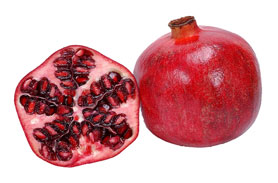The pomegranate (Punica granitum), highly touted these days as an antioxidant-rich superfruit, has an ancient metaphysical and culinary history. In fact, the image of the celebrated pomegranate was carved on the pillars of King Solomon’s temple and was referenced several times in the Bible’s Song of Songs of Solomon, as in the following verse:
Your cheek is like a half-pomegranate
Behind your veil.
(Song of Songs, 6:8)
The pomegranate has forever been likened to the shape of a woman’s breast. An age-old herbal principle called the Doctrine of Signatures suggests that if an herb resembles a part of the body, it is likely a medicine for that part of the body. Perhaps this recent report published in the January 2010 issue of the American Association for Cancer Research journal Cancer Prevention Research lends some credence to this bit of herbal folklore. Researchers at City of Hope Hospital in Duarte, Calif., discovered a suppressive effect of compounds found in pomegranate on the proliferation of estrogen-responsive breast cancer cells. Earlier research showed that ellagic acid in pomegranates inhibits the enzyme known as aromatase that converts androgen to estrogen hormones which fuel a common type of breast cancer.
Similar anti-cancer ellagic acids are also found in other fruits such as raspberries and besides their use to inhibit breast cancer, it seems that they are also effective for prostate cancer.
It might be a bit too early to say exactly how much pomegranate should be consumed to help fight estrogen-responsive breast cancer, but we may be encouraged to find that more and more research shows that all long-feted pomegranate’s recent grocery-store fame is more than just hype.


We have long been told that pomegranate elevates estrogen levels which can LEAD to breast cancer…